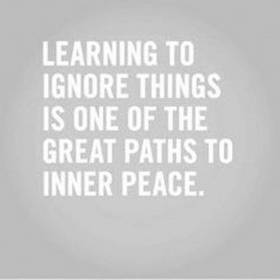Finding the Path to Inner Peace
What does it mean to have inner peace? In this “always in a rush” world, it can be challenging to establish and maintain feelings of inner peace. But if you work on it, you can discover how to cultivate a calm life that’s free of pettiness and turmoil.
Apply these ideas and strategies to pave your own road to serenity:
- Realize that your life matters. Regardless of who you are, you’re just as important as the next person. On the flipside, you’re also as insignificant as the next guy. When you understand this, it will help you tremendously in living an unaffected life.
- Refuse to judge others. It’s difficult to let go of the internal judge that we all seem to have. Noticing things we dislike about others, talking about those issues, and giving too much attention to things out of our control is a huge waste of our emotional resources.
- Focus on the positives in your life. Perhaps you have a great spouse, healthy kids, and a job that helps you live the lifestyle you want. Therefore, you’re rich by many standards.
- Find the “holes” in your life and plug them. In other words, if you have a few unhealthy habits you’d like to eliminate, target them one at a time, and change them.
- For example, maybe you say, “I’d have the greatest life ever if I could only [fill in the blank].” Then, figure out a way to achieve what’s lacking or alter how you see situations you’re unable to control.
- Recognize that you’re entitled to live a successful life. Forget about keeping up with your coworkers, neighbors, or close friends. What do you think reflects success for you? Live by your own standards.
- Be kind to others. It may sound like you’re back in kindergarten, but it’s important to be nice to those around you. Life often sweeps us away to the point that we’re so intent on accomplishing our goals that we lose sight of the fact that we’re all here together. Make time for small gestures of kindness to uplift those around you.
- Go on a personal crusade to find the goodness in you. What character traits do you possess that are desired and cherished by others and yourself? Know them. Acknowledge the goodness within you.
- Seek spiritual guidance and support. If you wish to be a part of an organized religion, visit various houses of worship until you find something that feels right to you. You’ll know it when you experience it.
- Practice yoga or another physical activity that fills you with peace. When you’ve engaged in physical activity to expend some energy, reaching a place of calm often follows.
- Consider reading about and practicing some form of meditation. Start out by meditating for ten minutes per day in the morning. Sit in a quiet room in a comfortable position. Stare at an item on the wall or close your eyes. Listen to your own breathing.
- Focus on how the air sounds with each breath. If it helps, say something repetitiously to yourself, like “in” and “out” in coordination with your breathing. Allow thoughts to flow in and out of your mind. You’ll feel surprisingly calm when you’re finished.
Finding your path to inner peace can be an adventure full of interesting experiences. Focus on achieving inner peace. You’ll ignite your passion for life. Namaste.
—–
3 Easy Ways to Add Joy to Your Daily Routines
Most of us live busy lives. Often, we’re so busy juggling tasks and responsibilities that we forget to take the time to do the things that bring us happiness. Unfortunately, a lack of joy in your daily life can lead to unhappiness, and it can even have long term negative consequences on your health.
Several well-known studies demonstrate that positive emotions, such as joy, have a profound effect on your health. One such study entitled “Positive Emotion and Health: Going Beyond the Negative,” was published in the July 2005 issue of Health Psychology. According to this study:
Joy and optimism provided a 51% reduction in the rates of heart disease among men who were followed for 10 years during the study.
Positive emotions such as joy and hope not only reduce the incidence of heart disease, but they also have a protective effect against high blood pressure, diabetes, and upper respiratory infections.
Thankfully, no matter how busy your life may be, there are steps you can take to instantly boost your mood and health.
Try one of these easy ways to add some joy back into your life each day:
Take time to appreciate and revel in activities that delight you. Whenever you feel your energy beginning to dwindle during the day, take a break and focus on something that brings you pleasure.
Giving yourself permission to have little “joy breaks” throughout your day will instantly lift your mood, as well as help you reduce stress and recharge your energy.
Simple things like savoring a cup of your favorite coffee or reconnecting with an old friend have the ability to bring you joy.
The important thing to remember is to take time each day to focus on those simple activities that make you feel happier.
Count your blessings. If you’re having a particularly difficult or hectic day, you might find it tempting to focus on the negative aspects of the day. Instead, try focusing on the things that are going in a positive direction and be thankful.
Feeling and expressing gratitude are very powerful. Taking time to reflect on better times in the past, as well as the things that are currently going well, can instantly lift your mood and give you the strength to keep working towards your goals.
Consider keeping a “blessings journal” so that you have a physical record of the good things in your life. This will help lift you up and encourage you during the difficult times.
Shake things up and do something new. The old adage, “familiarity breeds contempt,” is certainly true when it comes to our daily lives. Why not try something completely different to rediscover your joy?
Your imagination is the only limit. To get started, why not explore a new route to and from your workplace? You could also try out a new recipe that features a novel ingredient.
Consider learning a new skill or hobby. When looking for something to try, pay attention to the dreams you’ve had as a child and adult. For example, did you ever dream of traveling to a faraway country in the past? Consider taking classes to learn that country’s language and then plan a trip.
Remember to make time for laughter and fun throughout your day. Not only will you rediscover your joy, strengthen your health, and increase your own happiness, but your positive energy and outlook will also affect others around you and increase their level of joy, too!
—–
3 Crucial Steps to Healing a Broken Heart
The pain that we feel when our relationship with someone we love is ended can be very intense. Common symptoms of a broken heart include sadness, crying, and feeling physical aches and pains in the heart and body.
Symptoms of your grief can interfere with your health, well-being, and ability to function in your daily life!
If you’re dealing with the effects of a broken heart, you might be tempted to deny your feelings or withdraw from others so that no one can get close enough to hurt you again. However, denial and withdrawal are unproductive strategies.
Luckily, there are steps you can take to help you heal and move on, no matter how much time has passed since your break-up.
Try these strategies to begin to heal your broken heart today:
Cut off all contact and physically remove all reminders of your former love. Mementos from your life together hold you back from moving on. Just as a physical wound is unable to heal if you keep picking off the scab, holding on to anything that reminds you of your ex is simply going to prolong your misery.
Get rid of your ex’s belongings. If they no longer want these items, donate them to a thrift store or charity that accepts used clothing and similar items.
Remove pictures, gifts, love letters, or anything else that reminds you of your ex. Removing these reminders will help you to stop obsessing and rehashing past events.
Remember your online and digital profiles. Delete every picture, text, and email that you received from your ex, and remove their information from your devices.
Contact your friends and family members and let them know that the relationship is over. Ask them to avoid bringing up your ex. If your loved ones are having trouble complying with your request, you may need to limit your contact with them for a while.
Stop going to the places that you frequented as a couple.
By removing the physical reminders of your past life together, you’re literally clearing out both your mind and heart. This will allow you to grow and make a new life for yourself.
Take care of yourself as you heal. While it’s tempting to throw yourself into your work or drown your sorrows with too much food and alcohol, harmful escapes will only cause you to feel worse in the long run.
Eat healthy foods and consider joining an exercise class that helps you socialize while releasing excess energy and getting fit.
Start a new hobby. Great choices include taking classes to learn a new language or skill, or becoming a volunteer at a local school or charity.
Focus on coping strategies that will boost your health and self-esteem.
Remain calm if you run into your ex. If you live in the same town, chances are great that you’ll eventually run into your former love. Prepare yourself for this eventuality so that you can cope effectively. Focus on your breathing, and keep any exchange brief and polite.
Healing from a broken heart isn’t easy, but practicing these strategies will help you to begin the process. If you can heal your broken heart, you’ll be free, ready, and strong enough to love again, maybe even sooner than you think.
—–
Set Yourself Free by Leaving Your Past Behind
Everyone has a past. You’ve experienced exciting moments and wonderful memories that you’ll keep with you forever. Yet, you’ve also likely been through situations that were challenging and full of heartache. Certain things are always better left in the past. But how?
Put this knowledge to work to actively let go of your past:
Avoid trying to deny your past. It’s best to face up to what has transpired.
Acknowledge your own understanding of the painful events. Although we sometimes lack understanding about why those around us did what they did or how certain events happened (if we were young children at the time), we can use our adult reasoning skills to determine why things might have happened.
If you’re unable to gain an understanding, it’s okay. You may have struggled to make sense of things, but come up empty. Certain things are unable to be explained or understood.
Ask yourself if you’re ready to let go. Maybe you’ve unconsciously used your past to avoid moving forward and going after the life you deserve. Are you truly ready to let it go and start living a happier, more serene life?
Your past contributes to who you are today. Recognize that, although some elements of your past may be upsetting, you are who you are because of your childhood, parents, education, and other events from your past.
Seek to find strength in the fact that you’re made up of many things. You’re so much more than the negative experiences you’ve lived through.\
Look for the life lessons. Ask yourself what you may have learned from the painful events.
Avoid becoming cynical or negative. Avoid thinking things like, “No one will ever love me again,” or “Everything I’m involved in turns out poorly.”
Seek support when you need it. If you find yourself clinging to the negativity of your past, you might want to seek professional help to aid you in working through and releasing it.
Stage your own personal letting go ceremony. When you’re ready to release the things from your past that weigh you down, have a ceremony to mark the end of your personal pain.
For example, you could make a list of the past events or situations that have troubled you. Then, you can say aloud, “I’m done hurting from all of these things, and they’re not going to negatively affect my life ever again.” Next, go to a safe place, such as a fire pit, fireplace, or campfire, and set fire to your list. Watch that list burn!
When it’s gone, say, “I’ve taken power over you. My life without you starts now.”
Another example of a ceremony to let go is to collect a stone for each of your past hurts. Then, go to a lake or pond and throw each stone into the water, one at a time. You can say something like, “It’s time to let you go. You’ll no longer bring pain or sorrow to me.”
Designing your own letting-go ceremony can be liberating, so if you have ideas on how to release your old hurts, go for it.
You can let go of your past if you apply these strategies. It will take some focus and effort, but you have the power to embrace a new beginning. Discover the freedom of leaving your past behind.




